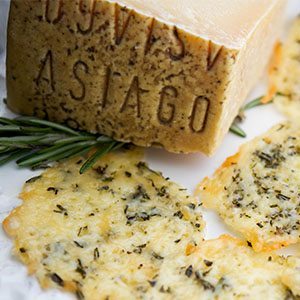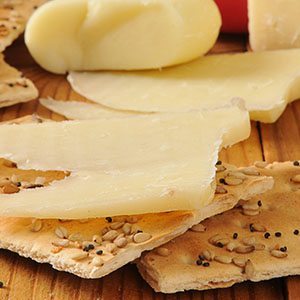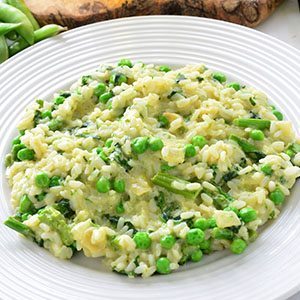The time: a thousand years ago. The place: the ragged and stunning beauty of the isolated Asiago Plateau, which lies between the Po River and the Southern mountains of the Valsugana Valley. The region will later become part of the Province of Vicenza and a popular and picturesque skiing destination. In summer, modern hikers will delight in meadows of knee-high wildflowers and savor the scent of vanilla orchids and fragrant herbs perfuming the crisp mountain air. But on the dawn of the eleventh century, it lies in the defunct Republic of Venice’s outskirts, remote and sparsely populated.
The bordering Astico and the Brenta mountain ranges shield the plateau against harsh winds and keep the air clear and clean. The land is isolated; shepherds are hard at work tending flocks of sheep and making cheese, a method of preserving their cattle’s milk and providing the shepherds with quality protein and fat year-round. The first “Asiago” is sustenance during long, fierce winters.
As the Renaissance flourishes and the population grows during the 1500s, cows replace sheep as the predominant grazing animal in the region’s mountain valleys. Cows produce more milk, and in turn, more cheese. Beginning in the early 1600s and over the ensuing centuries, cheesemakers of the plateau perfect the recipe for aged Asiago — also called Asiago d’Allevo or Asiago Stagionato.
These wheels are much the same today. They are relatively small in size, weighing in at 17.5 to 26.5 pounds, crafted with partially skimmed milk from cows freely grazing on the lush grasses and wildflowers of the valley. The cheese is traditionally aged to three different maturities — Asiago Mezzano (4-6 months), Asiago Vecchio (more than 10 months) and Asiago Stravecchio (more than 15 months).
Here at the foot of the Dolomite Mountains, people have been making cheese for a millennium — maybe more — and passing their deep knowledge and passion down to sons and daughters, and in turn, their sons and daughters. The delicious tradition continues today.

When World War I erupted, everything changed. On May 15, 1916, 2,000 Austrian artillery guns opened fire against the Italian lines near Asiago, which sat on the Italian side of the border between the Kingdom of Italy and the Austro-Hungarian Empire. The Battle of Asiago (Battaglia degli Altipiani in Italian) was the start of a grueling three-year defense of Italy’s borders, which ravaged the Asiago Plateau. The region’s gorgeous, mountainous countryside turned out to be a boon — the rough terrain helped diminish the Austrian enemy’s supply lines, protecting Italy from its invaders.
Suddenly, the sleepy countryside was flooded with upwards of 400,000 Italian troops, fighting to secure their country from the Austro-Hungarian forces. How to feed everyone? Asiago cheesemakers rose to the occasion. They could produce large quantities of Asiago, but the traditional cheese took too long to age. They needed a lot more cheese in much less time.
So instead of making aged Asiago with part skim milk that matured for months, they created a fresh Asiago. Their new cheese was made with whole milk and pressed, aged and ready for consumption in about a month. “In spite of all the destruction and loss of life,” says Nancy Radke, who runs Nancy Radke Culinary Consulting, “a new cheese, Asiago Fresco, was born.”
Asiago is the story of terroir — environmental factors and character. And Asiago is the story of generations of tradition, expertise, innovation and love.
Distinct Cheeses With Distinct Charms
It’s an understandable misconception that fresh and aged Asiago are different versions of the same cheeses. They are, in fact, different cheeses altogether.
What most of us picture when we think Asiago is aged Asiago, PDO (Protected designation of origin), also known as Asiago d’Allevo or Asiago Stagionato. This is the traditional hard, savory Asiago, made from partially skimmed cow’s milk. Only about 20 percent of the production of Asiago cheese is this aged variety, and much of it is slated for export.
Asiago Mezzano, matured for four to six months, is a semi-firm cheese. Its curd is compact, its color a pale yellow. As Asiago ages, its texture becomes harder and its flavor becomes more intense, complex and expressive. Asiago Mezzano is redolent of toasted hazelnuts and yeasty dough, with a sweet, caramelized finish. As the cheese matures — Vecchio is aged for at least 10 months and Stravecchio for 15 months or more — hints of nutmeg, black pepper and salted caramel emerge. About 10,000 wheels of Stravecchio are crafted each year.
Fresh Asiago, PDO also known as Asiago Fresco or Asiago Pressato, is delicate, with a pliable, almost squeaky texture and a milky flavor. There are lovely notes of tangy yogurt and rich cream — sweet, with balanced acidity. The cheese is made with fresh whole milk, placed into molds, pressed under pressure (hence the term pressato), and kept that way to accelerate its brief aging process — two months at most. The pressed curd “results in the proliferation of small apertures — not really ‘holes,’” says Steven Jenkins, author of the The Cheese Primer (Workman). Still, the curds pull apart easily, giving the pale, straw-colored cheese a holey, knobby appearance. While it is beloved in Italy, it is only now making its way to the United States.
Asiago On The Table

Both fresh and aged varieties of Asiago make wonderful snacks. With its firm texture and piquant flavor, aged Asiago, PDO is fun to pair with bubbly Prosecco or even sweet Moscato d’Asti. Soft and fruity reds like Barberas and Primitivos provide lovely balance, too. A plate of aged Asiago adorned with candy-sweet melon and smoky cured Speck guarantees a happy crowd.
Aged Asiago, PDO is hard enough to grate, and a beautiful melter. Toss with broccoli spears and olive oil and roast in a hot oven for an addictive veggie side. Asiago also makes a stellar addition to risotto — stir it in at the end of cooking for a luxuriously silky finish. Aged Asiago, PDO does wonders melted in a potato gratin (bacon optional), grated atop pasta and polenta, and sprinkled on bisque or white bean soup.
Soft, tangy and buttery enough to foil tannins, bold fruit and spice, Fresh Asiago, PDO pairs gorgeously with Chianti and Cabernet Sauvignon. Or serve with Sauvignon Blanc and a drizzle of honey for an elegant hors d’oeuvre.
Fresh Asiago, PDO is a perfect salad ingredient. Just cube and add to Mâche and steamed asparagus; or baby spinach and spring peas. Dress with a swig of good olive oil and season with salt and pepper and you have a perfect side dish. Or melt in your breakfast eggs, scrambled in butter and sprinkled with fresh herbs.
Pride Of Italy
Fresh Asiago, PDO and aged Asiago, PDO are true Italian originals. Domestic versions have become increasingly ubiquitous — but they are imitations and not the real deal. They often borrow the name without honoring the cheesemaking process, or even the distinctive flavor of real Italian Asiago.
The European Union awarded Asiago with PDO status in 1996. This name-protected designation ensures the product honors the environmental and cultural region in which it originated and is still made today.
Spring Pea, Asparagus and Asiago Risotto
Serves: 4

Ingredients:
6-8 cups chicken stock
3 Tbsp extra-virgin olive oil
2 shallots, chopped
2 cloves garlic, pressed or minced
1 cup Arborio or Carnaroli rice
½ cup dry white wine
1½ cups spring peas, shelled
1 bunch asparagus spears, steamed or roasted (1 pound)
3 Tbsp unsalted butter
1 cup grated Aged Asiago, PDO—Vecchio or Stravecchio (about 4 ounces)
Freshly ground salt and pepper
Handful fresh parsley, chopped, for garnish
Heat stock in a saucepan over medium heat; lower heat, and keep at a simmer.
Heat olive oil in a large heavy-bottom pan over medium heat. Add shallots, stirring for about 5 minutes, until they begin to soften and turn translucent.
Add rice and stir for about 3 to 4 minutes, until it is thoroughly combined with oil and shallots.
Add wine, and cook, until completely absorbed by rice, stirring continuously.
When wine is absorbed, use a ladle to add ¾ cup stock to rice mixture. Stir constantly with a wooden spoon. When rice starts to thicken significantly, add stock ¾ cup at a time, stirring after each addition.
About halfway through cooking, at about 10 minutes, add the peas and asparagus. Keep adding stock, one ladle at a time, stirring between each addition. When the mixture becomes the texture of heavy cream and the rice begins to turn translucent — a total of 18 to 20 minutes — remove from heat.
The rice should have give but not be crunchy, and the peas should be tender. Remove from heat. Stir in butter and Asiago, and season to taste with salt and pepper. Garnish with parsley and serve immediately.CC



